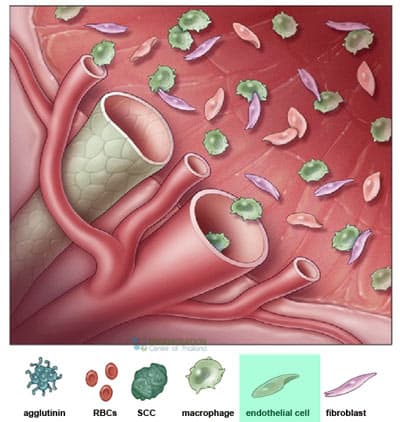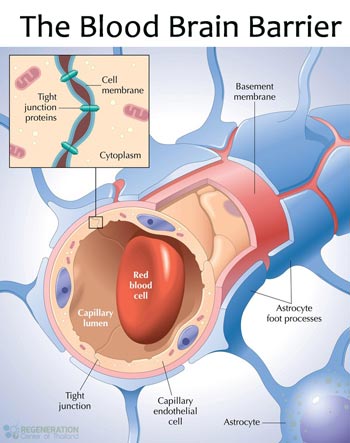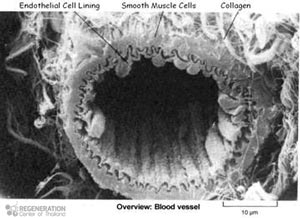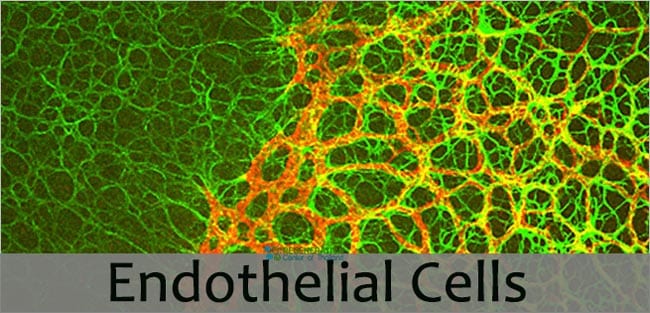Human Endothelial cells “EC” are estimated to account for nearly 1 kg of mass in the human body. This mass is about the same as our livers. Endothelial cells are thought to be produced by the splanchnopleuric mesoderm. These vital cells line the insides of all our blood vessels, including microscopic capillaries to larger arteries such as the aorta. The Endothelial cells help create a one-cell-layer (thickness) known as the endothelium. The endothelium can be found on the walls of a heart chamber and also on the carriers of blood plasma through the human body known as lymphatic vessels. In large blood vessels like arteries and veins, the endothelium layer forms thicker layers of fibers and muscle cells that are essential to our abilities to survive and function properly.[1]
Endothelial Cells Overview – VIDEO
Endothelial Cells “ECs” & The Blood Brain Barrier
The primary purpose of ECs is to help provide a safety barrier between our bodily tissues and blood. For our bodies to function properly, our blood must be contained safely inside a transporting lane, that allows certain proteins and chemical substances to move in and out of the blood vessels in a safe and controlled manner. Our endothelium is the perfect layer for such a task. It helps provide a selectively permeable layer (filter) in the blood vessel system that allows certain white blood cells and/or chemicals to move freely around in our bodies to go where they need to go without restriction.[2]

The primary role of the endothelium as a protecting barrier is especially critical around the neural pathways. Our endothelial cells are also part of blood-brain barrier “BBB.” The blood brain barrier is a thin layer that helps to separate flowing blood flowing vessels around the brain from our brain tissue, cerebrospinal fluid and neurons.
Epithelial Cells vs Endothelial cells
Epithelial cells are usually found coated around the inner surface of our internal organs where Endothelial cells are usually found lined in the interior surfaces of blood vessels. Our endothelial cells act very much like a sieve or filter, that restricts the passage of larger molecules,bacteria or toxic substances into our brain tissue while allowing the necessary molecules such as hormones, oxygen,cytokines and enzymes to pass safely and without restriction. The filtering function also allow waste like carbon dioxide (produced by our neurons) to easily diffuse out of our brains and back into our bloodstream for disposal.[3]

Endothelial stem cells or “ESC” are one of 3 types of adult stem cells that are found in our bone marrow. EDCs are multipotent, which means that they have the distinct ability to give “birth” to many type of cells. This is slightly different than pluripotent cells which can give “birth” to nearly all types of cells in the human body. Like stem cells, endothelial cells can also self-renew and differentiate. Endothelial stem cells help form progenitor cells, that basically act like in termediate stem cells and lose their potency. Progenitor cells are locked from being able to further differentiate. Endothelial stem cells eventually produce endothelial cells “EC”, which then form to create the thinly-walled endothelium layer that line the inner surfaces of our blood and lymphatic vessels.
termediate stem cells and lose their potency. Progenitor cells are locked from being able to further differentiate. Endothelial stem cells eventually produce endothelial cells “EC”, which then form to create the thinly-walled endothelium layer that line the inner surfaces of our blood and lymphatic vessels.
Endothelial progenitor cells “EPC” are a small population of rare and unique cells that are constantly circulating in the blood vessels and have the unique capacity to differentiate into endothelial cells that help to make the lining of all our blood vessels. Vasculogenesis is the natural process where blood vessels are created in our bodies from endothelial progenitor cells.
Endothelial progenitor cells also participate in pathologic angiogenesis such as that found in retinopathy and tumor growth. Endothelial progenitor cells are also very important in tumour growths and are vital for the process of angiogenesis and metastasis. Various growth factors,cytokines and hormones can cause hematopoietic and endothelial progenitor cells to be mobilised into our peripheral blood circulation system ultimately leading to blood vessel formation. At the regeneration center, Endothelial progenitor cells are usually marked and identified in stem cell therapies using a flow cytometer.
To learn more about Endothelial progenitor cells or if you have any other questions please contact us today.
Published Clinical Citations
[1] ^ Busse, R. & Fleming, I. Vascular endothelium and blood flow. Handb. Exp. Physiol. 176, 43–78 (2006)
[2] ^ Minshall, R. D. & Malik, A. B. Transport across the endothelium: regulation of endothelial permeability. Handb. Exp. Pharmacol. 176, 107–144 (2006)
[3] ^ Aird, W. C. Phenotypic heterogeneity of the endothelium: I. Structure, function and mechanisms. Circ. Res. 100, 158–173 (2007) https://www.ahajournals.org/doi/full/10.1161/01.res.0000255691.76142.4a

